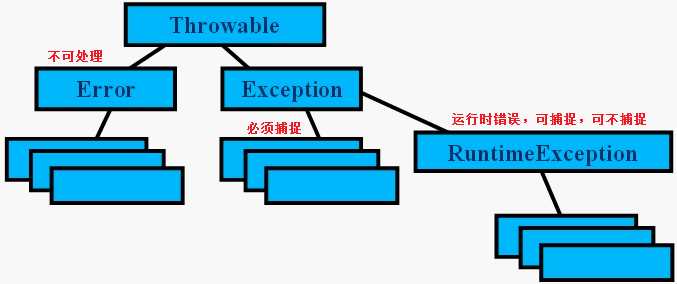- java异常是Java提供的用于处理程序中错误的一种机制。
- 所谓错误是指程序在运行过程中发生的一些异常事件(如除数为0、数组下标越界、操作的文件不存在等)。
- Java程序在执行过程中如果出现异常事件,可以生成一个异常类对象,该异常对象封装了异常事件的信息并将被提交给Java运行时系统,这个过程称为抛出(throw)异常。
- 当Java运行时系统收到异常对象时,会寻找能处理这一异常的代码并将对当前异常对象交给其处理,这一过程称为异常捕获(catch)。
JAVA中的异常类都继承自Throwable类,也就是说,这是异常类的根。Throwable类扩展了两个类Error类和Exception类,Exception类又扩展了一个RuntimeException类。如下图:

- Error:称为错误,由Java虚拟机生成并抛出,这类错误一般是运行时系统内部的错误,无法被处理。
- Exception:所有异常类的父类,其子类对应了各种各样可能出现的异常事件,一般需要用户显式地声明或捕获。如文件类异常:FileNotFoundException,IOExecption。
- RuntimeException:一种特殊的异常类,继承自Exception类。如除数为0、数组下标越界等。这类异常产生比较频繁,用户一般不对其做捕获处理,否则对程序的可读性和运行效率影响很大,而是由系统自动检测并将它们交给默认的异常处理程序进行处理。如ArithmeticException,ArrayIndexOutOfBoundException。
一般来说,出现RuntimeException异常表示的是代码不合理而出现的问题。
- 未检查异常:Error错误和RuntimeException类的异常;
- 已检查异常:Exception类的异常但不包括RuntimeException类。
因此,在自定义异常类型时,大多数都直接继承Exception类,偶尔可能继承RuntimeException类,更偶尔的可能会继承这些类的某些子类。
try-catch-finally结构和处理流程
使用try-catch结构捕捉异常,并设置捕捉到后的处理方式。还可以加上finally结构,这是可选结构,但却表示try结构中必须会被执行的部分。
以下是try-catch-finally结构和处理过程的分析。
try {
// 待捕捉测试的代码1
// 待捕捉测试的代码2 (假设此为异常代码,将抛出名为异常名2的异常)
// 待捕捉测试的代码3
} catch (异常名1 对象名e) {
// 捕捉到异常名1的异常后,该做的处理代码4
} catch (异常名2 对象名e) {
// 捕捉到异常名2的异常后,该做的处理代码5
} ... {
//...
} finally {
//一定会执行的代码6
}
//try结构外的代码7
前提假设,在各代码中没有return子句。执行过程为:首先代码1正常执行,到代码2处抛出异常名2的异常,通过异常名匹配,将选择第二个catch结构,于是将异常2封装到对象名e中,并执行代码5处理异常。catch部分处理完后,还有最后处理段finally,于是执行代码6。出了finally后,还将执行代码7。
注意,当代码2出现异常后,代码3不会执行。而finally则是无论是否真的捕捉到了异常、是否在catch段有return都会执行的代码段。换句话说,finally段的代码除了内部错误或外界影响都一定会执行。就像下面的例子中,即使catch使用了return,但finally还是会执行,只不过这个catch终止了try结构外的代码。
例如,除数为0时会抛出ArithmeticException异常。try-catch捕捉它:
public class TEx {
public static void main(String[] args) {
try {
System.out.println("[start]");
System.out.println(2/0);
System.out.println("[end]");
} catch (ArithmeticException e) {
System.out.println("[Catching]: " + e);
return;
} finally {
System.out.println("[Finally]");
}
System.out.println("[out of try-catch]");
}
}
在finally段中还可以继续try-catch-finally,防止该段落的代码再次抛出异常。
public class TEx {
public static void main(String[] args) {
try {
System.out.println("[start]");
System.out.println(2/0);
System.out.println("[end]");
} catch (ArithmeticException e) {
System.out.println("[Catching]: " + e);
return;
} finally {
try {
System.out.println("[Finally-try-start]");
System.out.println(3/0);
} catch (ArithmeticException e) {
System.out.println("[Finally-Catching]: " + e);
}
}
System.out.println("[out of try-catch]");
}
}
输出异常信息
java中的异常都会封装到对象中。异常对象中有几个方法:
- printStackTrace():输出最详细的信息,包括抛出异常的行号,异常信息以及异常原因。
- getMessage():输出异常信息。
- getCause():输出异常原因。
异常抛出过程和throw、throws关键字
throw关键字用于在某个语句处抛出一个异常,只要执行到这个语句就表示必定抛出异常。
throws关键字用于在方法处抛出一个或多个异常,这表示执行这个方法可能会抛出异常。
throw OBJECT;
throw new EXCEPTION("Message");
method() throws EXCEPTION1[,EXCEPTION2...] {}
对于Exception类(非RuntimeException)的异常即已检查异常类,在调用时要么进行捕捉,要么继续向上级抛出。这类错误产生和处理的过程为:
- 方法f()内部的方法体的throw向上抛出给方法f();
- 方法f()的throws向上抛出抛给f()调用者;
- 方法调用者必须捕捉处理,或者不想捕捉就继续向上抛出;
- 每一级的调用者都不想捕捉而是一直向上抛出,则最后由java虚拟机报错:"未报告的异常错误XXXX必须对其进行捕获或声明以便抛出"。
以下是抛出异常的一个简单示例,抛出的是ArithmeticException异常,因为是RuntimeException类异常,因此从方法体内部throw抛出后,无需在方法定义处使用throws继续抛出。
public class EX {
void f(int n) { // 或void f(int n) throws ArithmeticException {}
if (n == 0) {
throw new ArithmeticException("hello Exception!");
} else {
System.out.println("right!");
}
}
public static void main(String[] args) {
EX m = new EX();
m.f(1);
m.f(0); // throw Exception
}
}
执行结果:
right!
Exception in thread "main" java.lang.ArithmeticException: hello Exception! //异常的信息
at EX.f(EX.java:4) //真实产生异常的地方
at EX.main(EX.java:13) //调用产生异常的地方
所以,对于RuntimeException类异常来说,是否使用throws关键字并无影响。一般来说,Exception类异常但非RuntimeException才需要使用throws关键字,因为Exception类异常必须要被捕获并处理,而RuntimeException异常则无所谓。
例如将上面的ArimeticException改为FileNotFoundException,前者为Runtime类异常,而后者为Exception但非Runtime类异常,因此使用throw抛出后,必须在定义方法处也使用throws抛出错误。这一过程是"向上级抛出"的过程:"方法体内部抛出异常-->抛给方法本身"。
void f(int n) throws FileNotFoundException {
if (n == 0) {
throw new FileNotFoundException("hello Exception!"); //throw a new yichang duixiang
} else {
System.out.println("right!");
}
}
如果不使用throws关键字抛出错误,则将报错:
EX.java:6: 错误: 未报告的异常错误FileNotFoundException; 必须对其进行捕获或声明以便抛出
throw new FileNotFoundException("hello Exception!"); //throw a new yichang duixiang
从方法f()抛出向上抛出给调用者后,调用者要么使用try-catch捕捉,要么继续向上抛出,否则报错。例如捕捉
import java.io.*;
public class EX {
void f(int n) throws FileNotFoundException {
if (n == 0) {
throw new FileNotFoundException("hello Exception!");
} else {
System.out.println("right!");
}
}
public static void main(String[] args) {
try {
EX m = new EX();
m.f(0);
} catch (FileNotFoundException e) {
System.out.println(e);
}
System.out.println("out of try-catch");
}
}
如果不捕捉,则可以继续在方法处向上抛出:
public static void main(String[] args) throws FileNotFoundException {
EX m = new EX();
m.f(0);
}
抛出异常时的注意事项
throw可以同时定义可能抛出的多种异常,尽管这些异常存在继承关系。这时在捕捉异常时,应该先捕捉子类,再捕捉父类。
例如FileNotFoundException是IOException的子类,可以同时:
throws FileNotFoundException,IOException
捕捉时应先捕捉FileNotFoundException,再IOException。
try {
...
} catch (FileNotFoundException e) {
...
} catch (IOException e) {
...
}
在重写有throws子句的方法时,需要注意:
- 子类重写父类方法要抛出与父类一致的异常,或者不抛出异常
- 子类重写父类方法所抛出的Exception类异常不能超过父类的范畴
- 子类重写父类方法抛出的异常可以超出父类范畴,但超出的部分必须是RuntimeException类的异常
所以下面的定义中,前子类1-3重写和子类5-7都是有效的,但子类4重写是错误的。
父类:method() throws IOException {}
子类1:method() throws {}
子类2:method() throws IOException {}
子类3:method() throws FileNotFoundException {}
子类4:method() throws Exception {}
子类5:method() throws RuntimeException {}
子类6:method() throws IOException,RuntimeException {}
子类7:method() throws IOException,ArithmeticException {}
自定义异常
异常是类,当产生异常时会构建此类的异常对象。
自定义异常时需要考虑异常类的构造方法是否接参数,参数需要如何处理实现怎样的逻辑。
自定义的异常一般都从Exception继承。
例如下面定义了一个银行卡存、取钱时的程序,其中自定义了一个Exception类错误。
// User Define Exception
class OverDrawException extends Exception {
private double amount;
public OverDrawException(double amount) {
this.amount = amount;
}
public OverDrawException(String message) {
super(message);
}
public double getAmount() {
return amount;
}
}
// Card class
class Card {
//cardNum:卡号,balance:余额
private String cardNum;
private double balance;
Card(String n,double b) {
this.cardNum = n;
this.balance = b;
}
//方法:存钱
public void cunQian(double n) {
balance += n;
}
//方法:取钱
public void quQian(double n) throws OverDrawException {
if (n <= this.balance) {
balance -= n;
} else {
double need = n - balance;
throw new OverDrawException(need);
}
}
//方法:返回余额
public double getBalance() {
return this.balance;
}
}
public class SuanZhang {
public static void main(String [] args) {
try {
Card card = new Card("62202",300);
System.out.println("卡里余额:" + card.getBalance());
//存钱
card.cunQian(200);
System.out.println("余额:" + card.getBalance());
//取钱
card.quQian(600);
System.out.println("余额:" + card.getBalance());
} catch (OverDrawException e) {
System.out.println(e);
System.out.println("抱歉!您的余额不足,缺少:" + e.getAmount());
}
}
}
注:若您觉得这篇文章还不错请点击右下角推荐,您的支持能激发作者更大的写作热情,非常感谢!
